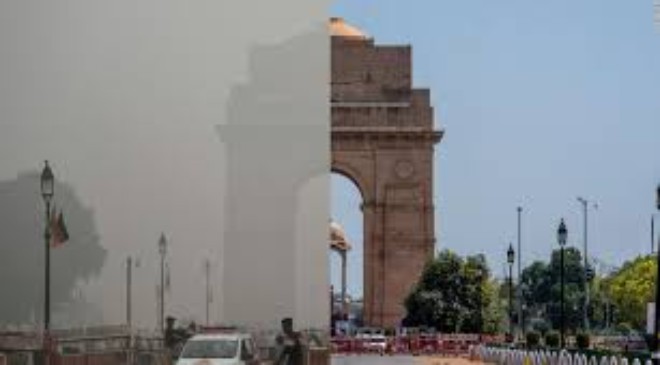Delhi’s remained in the ‘Very Poor’ category on Thursday with an Air Quality Index (AQI) of 343, while Noida reported an even worse AQI than the national capital, registering an AQI of 397.
Read More:- In A First, US Fed Keeps Interest Rates Unchanged For Second Time
New Delhi: Amid continuously deteriorating air quality and increasing pollution, Delhi’s AQI remained in the ‘Very Poor’ category on Thursday with an Air Quality Index (AQI) of 343, as per the System of Air Quality and Weather Forecasting And Research (SAFAR) – India. Meanwhile, Noida reported an even worse AQI than the national capital, registering an AQI of 397, which indicates ‘very poor’ air quality. In response to the worsening air quality, the Delhi Government has implemented several measures, including a ban on the entry of diesel buses from Haryana and an increase in the number of CNG buses. Delhi’s Environment Minister, Gopal Rai, stated on Wednesday that the next 15-20 days are crucial for Delhi due to a drop in temperatures and calm winds.
For five consecutive days, the air quality in the national capital has persistently remained in the ‘very poor’ category, with an Air Quality Index (AQI) reaching 372 at 10 am. This marks the highest AQI recorded this season, all while the minimum temperature was noted at 16.4 degrees Celsius. In several areas of Delhi, including Anand Vihar, Bawana, and Rohini, the AQI has now crossed into the ‘severe’ category.
Delhi Air Pollution: Areas wise AQI
The air quality in the national capital has consistently stayed within the ‘very poor’ category for a continuous five-day period. At 10 am, the Air Quality Index (AQI) peaked at 372, marking the highest reading of the season, while the minimum temperature was recorded at 16.4 degrees Celsius. Notably, in various areas of Delhi, including Anand Vihar, Bawana, and Rohini, the AQI has reached the ‘severe’ category.
The 24-hour average Air Quality Index (AQI) for the mentioned dates was as follows: 359 on Tuesday (October 31), 347 on Monday (October 30), 325 on Sunday (October 29), 304 on Saturday (October 28), and 261 on Friday (October 27). In various areas across the city, including Nehru Nagar (402), Sonia Vihar (412), Rohini (403), Wazirpur (422), Bawana (403), Mundka (407), Anand Vihar (422), and New Moti Bagh (435), there was a significant decline in air quality. The AQI scale categorizes air quality as follows: 0-50 “good,” 51-100 “satisfactory,” 101-200 “moderate,” 201-300 “poor,” 301-400 “very poor,” and 401-500 “severe.”
Read More:- ‘My father landed in US with $25 in pocket’: YouTube CEO Neal Mohan shares childhood memories of India
Every Third Child in Delhi Asthmatic
The Delhi High Court has expressed its concern over the deteriorating air pollution and stated that it is the responsibility of the authorities to ensure that the air quality index (AQI) comes down, citing every third child in the national capital is asthmatic.
The court made this statement while assessing different aspects of enhancing Delhi’s greenery, including the process of deconcretizing trees to provide them with more breathing room, eliminating encroachments from the Southern Ridge area, and designating a new forest area for preservation.
Delhi Air Pollution: Ban On Construction Activity
Minister Rai has announced that the Delhi Government will impose a ban on construction activities in areas where the Air Quality Index (AQI) surpasses the 400-mark for the next five days. Despite the implementation of preventive measures outlined in Stage 2 of the central government’s air pollution control plan, pollution levels continue to escalate. Consequently, construction work will be temporarily suspended within a 1-kilometer radius of areas with an AQI exceeding 400 for five consecutive days, according to his statement.
The minister has also instructed nodal officers to rigorously enforce air pollution control measures in these affected areas. Furthermore, the Delhi government has issued directives to all departments and resident welfare associations to distribute heaters to security guards as a preventive measure against biomass burning.
Delhi Air Pollution: Weather Condition, Stubble Burning Primary Reasons
Adverse meteorological conditions, along with emissions from firecrackers, stubble burning, and local sources of pollution, combine to push the air quality in Delhi-NCR to hazardous levels during the winter season. According to the news agency ANI, there have been over 2,500 reported cases of stubble burning this year.
Delhi Air Pollution: GRAP In Action
The second phase of the Graded Response Action Plan (GRAP) has been implemented to reduce air pollution. The Graded Response Action Plan (GRAP) includes a framework of directives and actions aimed at mitigating air pollution within the National Capital Region (NCR) of India, encompassing Delhi and its neighbouring areas. According to an official statement from the Ministry of Environment, the second phase of GRAP will entail several measures in Delhi NCR, including a prohibition on the use of coal and wood-burning stoves, an upsurge in the frequency of CNG and electric buses, routine road cleaning, and the application of water to control dust, as well as the deployment of traffic police personnel to maintain smooth traffic flow, thereby contributing to pollution control.
Read More:- RBI’s floating rate savings bonds: Why should investors invest in them?
Delhi Air Pollution: Air Quality Index
The Air Quality Index (AQI) is a practical tool for measuring air quality conditions in an easily comprehensible manner. It is divided into six AQI categories: Good, Satisfactory, Moderately Polluted, Poor, Very Poor, and Severe. An AQI ranging from 201 to 300 falls into the ‘poor’ category and is categorized under Stage 1 restrictions. AQI levels between 301 and 400 are classified as ‘very poor,’ falling under Stage 2. An AQI of 401 to 450 is designated as ‘severe’ and falls under Stage 3.



































